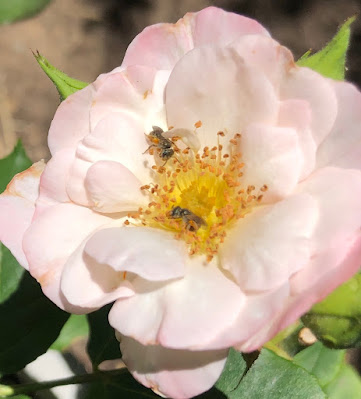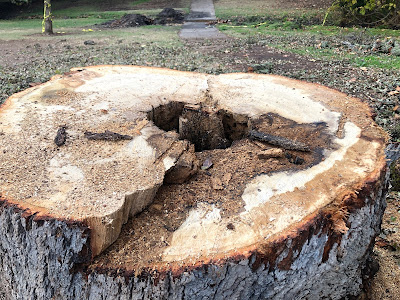
Many native species sleep in the soil

|
|
During spring and summer, sweat bees such
as these can be seen foraging on many
blooming plants. (Photos: Kathy Morrison)
|
Mulch is a wonderful thing, and we have lots of free mulch falling from our trees now. But please don't cover every inch of the garden with it. The native bees we've worked so hard to entice to our plants need some bare soil.
Many California species -- and there are about 1,600 native bee species -- nest underground. Honeybees, which are not native, live in hives, of course. Native carpenter bees do what they're named for: carve holes in fence posts and other wood for their nests.
But other bees are solitary. Smaller than honeybees, sometimes tiny, they nest in soil holes barely the width of a pencil lead, usually in flat, sunny spots. Some bee species nest in already-existing cavities or holes.
I was able to see ground-nesting bees up close earlier in the year when I was adding new chip mulch around my rose bushes. Suddenly 5 or 6 little bees appeared, hovering in a rather agitated manner. I scraped back the chips they were flying over and, sure enough, there were little holes in the ground near the base of one bush. I found other tiny holes at the edge of the same planting area, near the driveway. I watched one bee crawl into its hole.
Now I'm more cautious about what I cover up, and am careful to leave some areas uncovered in each planting bed. (Note: Mulch shouldn't come right up against stems or trunks anyway, since that can promote rot.)
Now, leaf mulch or leaf litter does offer protection for bumble bee queens, and butterfly and moth species, as well as that gardener favorite, the lady beetle. So do leave some leaves!
Pollinators may go into hibernation when the weather turns colder, but they don't go away entirely. And we want them back in spring.
(For more on pollinators and winter, check out this excellent post from the Xerces Society.)
A postscript on an oak tree

|
|
This is the remaining stump from the blue oak that
lost its leader branch in late October.
|
Sure enough, it's been cut down to the final few feet of its 4-foot-wide trunk. I peeked at the stump and wasn't surprised to see the center rotted out. We're probably lucky that the branch fell when it did, rather than the entire tree falling down and taking out a lot of the nearby trees and the utility building next to it -- and potentially harming park visitors.
But I will miss this tree.
Comments
0 comments have been posted.Sacramento Digs Gardening to your inbox.
Sites We Like
Garden Checklist for week of May 12
Get your gardening chores and irrigation done early in the day before temperatures rise.
* Plant, plant, plant! It’s prime planting season in the Sacramento area. Time to set out those tomato transplants along with peppers and eggplants. Pinch off any flowers on new transplants to make them concentrate on establishing roots instead of setting premature fruit.
* Direct-seed melons, cucumbers, summer squash, corn, radishes, pumpkins and annual herbs such as basil.
* Harvest cabbage, lettuce, peas and green onions. This heat will cause leafy greens and onions to flower; pick them before they bolt.
* In the flower garden, direct-seed sunflowers, cosmos, salvia, zinnias, marigolds, celosia and asters.
* Plant dahlia tubers. Other perennials to set out include verbena, coreopsis, coneflower and astilbe.
* Transplant petunias, marigolds and perennial flowers such as astilbe, columbine, coneflowers, coreopsis, dahlias, rudbeckia and verbena.
* Keep an eye out for slugs, snails, earwigs and aphids that want to dine on tender new growth.
* Feed summer bloomers with a balanced fertilizer.
* For continued bloom, cut off spent flowers on roses as well as other flowering plants.
* Got fruit trees? If you haven't already done so, thin orchard fruit such as apples, peaches, pears, pluots and plums before they grow too heavy, breaking branches or even splitting the tree. Leave the largest fruit on the branch, culling the smaller ones, and allow for 5 to 6 inches (or a hand's worth) between each fruit.
* Thin grape bunches, again leaving about 6 inches between them. For the remaining bunches, prune off the "tail" end, about the bottom third of the bunch, so that the plant's energy is concentrated in the fruit closest to the branch.
* As spring-flowering shrubs finish blooming, give them a little pruning to shape them, removing old and dead wood. Lightly trim azaleas, fuchsias and marguerites for bushier plants.
* Add mulch to the garden to help keep that precious water from evaporating. Mulch also cuts down on weeds. But don’t let it mound around the stems or trunks of trees or shrubs. Leave about a 6-inch to 1-foot circle to avoid crown rot or other problems.